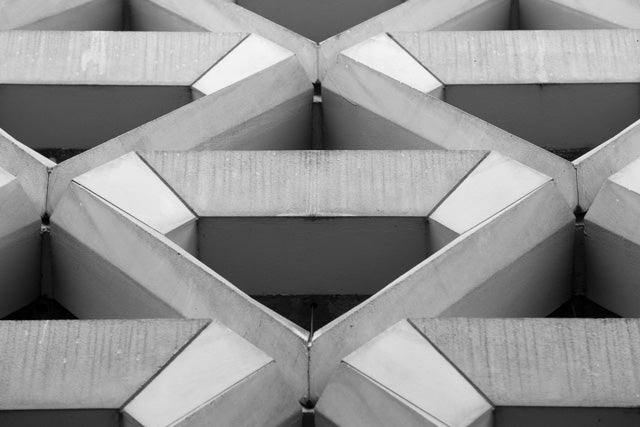 Kimberley Harris trained at the Welsh School of Architecture and has been practicing as an architect in Wales for the last seven years, working for both small architectural and multidisciplinary practices. She has a wide range of experience across a number of sectors including education, healthcare, infrastructure and high-rise residential refurbishment. Kimberley is also a huge fan of brutalism, so we asked her for some of her views on concrete.
Kimberley Harris trained at the Welsh School of Architecture and has been practicing as an architect in Wales for the last seven years, working for both small architectural and multidisciplinary practices. She has a wide range of experience across a number of sectors including education, healthcare, infrastructure and high-rise residential refurbishment. Kimberley is also a huge fan of brutalism, so we asked her for some of her views on concrete.What are the main advantages of using concrete as a building material?
Aesthetics of course! Concrete is fluid until you tell it what shape it needs to be, so as an architect it's the most exciting material you can work with. The finish can be controlled through the selection of formwork or be post worked, with, for example, the application of acids. You can easily change the colour and visual appearance through admixtures and aggregates.
If you choose to work with pre-cast elements, you can create highly accurate, factory-finished components and make significant cost savings in terms of the proportion of program allocated to wet trades on site, but there are lead-in times to consider.
Concrete and masonry in general has a high thermal mass (the ability of a material to absorb and store heat energy). A lot of energy is required to change the temperature of high density materials so their temperature remains somewhat constant. This can offer a client increased energy efficiency as the structure will absorb heat during the day and release it gradually at night, but this does require external insulation or the use of ‘sandwich’ panels to prevent heat rapidly escaping into the external environment. It’s this ‘cold bridging’ that has driven the over-cladding of many buildings from the 1960s.
What are the drawbacks, and how do you overcome these?
Good concrete can’t be produced from an improper mix, so there’s a significant amount of testing and experimentation that needs to be undertaken before sign-off, alongside ensuring that the material also hits specification in terms of thermal and structural performance.
In terms of structural performance, all load-bearing concrete will be designed with reinforcement bars (rebars). Bar bending schedules do take some time to produce and, depending on the structural performance required, the weight of steel needed can become costly. The superstructure methodology needs to be considered at feasibility stage to allow for a proper assessment of material suitability alongside early design input from structural and civil engineers.
Concrete structures also need regular maintenance to check for spalling (pieces breaking off). As soon as rebars becomes exposed you run the risk of corrosion.
What’s your favourite example of concrete use in architecture?
 Michael Blampied's Welbeck Street Car Park © Nick Miners
Michael Blampied's Welbeck Street Car Park © Nick Miners
In Architecture ‘brutalism’ is often assumed to be derived from an overbearing ‘brutal’ aesthetic, but this really isn’t the case. The name was actually derived from ‘béton brut’ - A french term that August Perret (tutor to both Le Corbusier and Ernő Goldfinger) used in the early twentieth century for rough cast concrete. It was utilized heavily during the second world war for the construction of military bunkers, as its rough surface reflected radar waves in varying directions, so locating them became more of a challenge.
Evident through events like the Festival of Britain, there was a strong desire to utilise the construction technologies and skills gained during WWII to address the immediate housing crisis and rebuild those cities that received heavy damage in the blitz. This gave rise to some of the most experimental building proposals that this country had seen for decades. It was an exciting time for architecture and city planning.
If I had to pick my top three buildings:
Michael Blampied’s NCP at Welbeck Street. When I took an interest in Brutalism towards the end of my architectural education at the Welsh School, Welbeck was one of the first buildings I photographed. I fell in love with pre-cast concrete facades. The simple geometry creates an incredible beauty when the sun floods through the centre of each triangle in the early afternoon. Where is the campaign for listing?
Tadao Ando’s Church of the Light. It's primarily built using only two materials; the mass and the weight of the concrete is broken so it works in juxtaposition with the delicate properties of light. The building effectively becomes a shadow box. Unlike many religious buildings, the daylight becomes the main focus of ornamentation, perhaps drawing parallels to light as presence of deity.
 Ernő Goldfinger's Balfron Tower in Poplar, East London © Nick Miners
Ernő Goldfinger's Balfron Tower in Poplar, East London © Nick Miners
Goldfinger’s Towers at Trellick and Balfron. If you’ve visited either of those sites, you’ll understand what I mean when I talk about the impact of scale. From the ground, both buildings are powerful and even a little overbearing, but the apartments themselves are incredibly well designed. Circulation space is limited to every third floor and the noisy elements of the building are completely detached from the living space.
Do you think brutalism in particular, and concrete in general, gets an unfairly bad reputation?
I think post-war housing gets a bad reputation and that developers have a tendency to exaggerate this reputation when they realise that they could make huge profits through increasing density on inner city sites. I also believe our councils are in a situation where they are forced to work alongside developers to improve their housing stock, because maintenance budgets have been so low for so long. Gone are the days when councils had their own architectural departments.
If you actually look at the crime statistics, they’re a lot lower than the media would have you believe.
RIBA's campaign to get Preston Bus Station listed in 2012 drew attention to brutalism again, and the appetite for it amongst creatives has really taken off, particularly in a time where austerity is at the forefront of the political agenda. More people than ever are doing their research into planning issues and arguing the case for the preservation of brutalist architecture. Unfortunately Robin Hood Gardens in Poplar is a Listing battle that was never won and now faces imminent demolition.
I undertook a significant amount of research into post-war high-rise to inform a project I was working on here in Cardiff. I read numerous interview transcripts, and I’ve watched hundreds of documentaries on the plight of social housing. Yes, residents have maintenance issues, but the drivers for demolition and regeneration rarely come from them.
As I briefly mentioned above with regards to Balfron and Trellick, the beauty of many of these buildings can be found in their efficiency and the solutions they offered to immediate need. Beauty is in the eye of the beholder.
Follow Kimberley on Twitter




